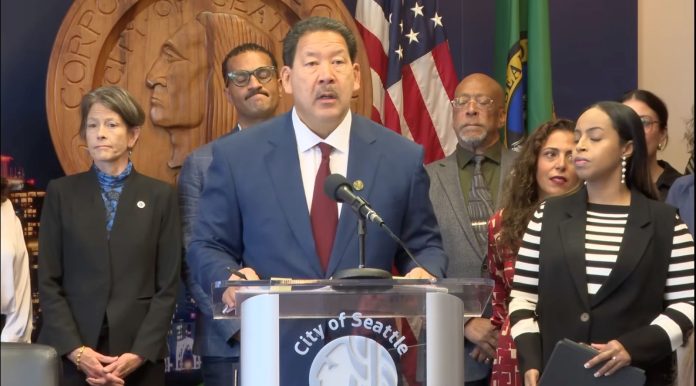
It may take more to dissuade the Trump administration, based on other cities’ experiences.
Local leaders are struggling to formulate a meaningful response to President Donald Trump’s aggressive plans to increase local immigration enforcement and illegally send the National Guard to Democrat-run cities such as Seattle.
In October, Mayor Bruce Harrell released two executive orders to address the situation. One of them creates a task force and suggests coordination with the Seattle City Attorney’s Office, while the other pledges two ordinances Harrell will bring forward, professes support of immigrant and refugee communities, and tells the Seattle Police Department (SPD) to prepare a directive to provide guidance on activities related to immigration enforcement.
“We cannot be underprepared by any stretch of the imagination at this critical moment when Trump is escalating his attacks on cities and carrying out what we believe is a cruel deportation agenda,” Harrell said at a press event. “And he’s doing it with masked un-uniformed officers.”
Meanwhile, in June, Seattle Police Department (SPD) Shon Barnes made the dramatic pronouncement before the Seattle City Council that he expects to be jailed for standing up for Seattleites’ first amendment rights.
Last week, at the height of campaign season, Harrell dropped the first piece of new legislation proposed in his executive orders, which would ban face coverings (with some exceptions) for law enforcement.
In reality, these executive orders and proposed ordinance fail to clearly delineate how the City and SPD will respond to the U.S. Immigrations and Customs Enforcement (ICE) should that agency engage in behavior such as kidnappings and the use of chemical weapons against protesters trying to protect their immigrant neighbors. Instead, they merely stipulate that this work needs to be done.
The ban on face coverings for ICE agents, a civil offense that comes with a fine of $5,000, doesn’t appear to offer much practical recourse should federal agents choose to mask to continue to provide themselves with anonymity. ICE has flaunted state and local laws on numerous occasions, including California’s recent statewide ban on masked agents.
And there’s no guarantee touting Seattle’s falling crime numbers as a reason Trump won’t send the National Guard will be effective, given Portland is in a similar position, saying Trump’s attempt to send troops to their city is a “manufactured crisis.”
Meanwhile, local officials’ concern about the fate of immigrants and those protesting Trump’s actions only extends so far. In February, the council chose to pass legislation expanding SPD’s allowed use of less-lethal weapons such as pepper spray and blast balls. In September, the council approved a rushed expansion of surveillance cameras in the city, in spite of a slew of public comments expressing concerns of possible impacts of surveillance on the immigrants living in the city.
In contrast to the council’s seeming indifference to heightened ICE enforcement, last week Councilmember Alexis Mercedes Rinck put forth a budget statement of legislative intent (SLI), included in Budget Chair Dan Strauss’s balancing package, that was supported by all her colleagues except Council President Sara Nelson.
Rinck’s SLI requires SPD to provide a report to the council’s Public Safety committee on March 1, 2026, detailing the department’s implementation plan for Harrell’s two executive orders. The report will include information about whether Seattle’s three accountability bodies are participating in developing SPD’s directive to their officers on how to respond to incidents with federal immigration agents, as well as whether this directive will become part of SPD’s Policy Manual.
The SLI lists a variety of scenarios with federal immigration enforcement for which officers should be provided clear guidance, including when ICE officers use excessive force, when individuals impersonate federal law enforcement, and how SPD will plan to address traffic safety and crowd control when ICE officers request it during immigration enforcement operations.

“Over the past year, we have seen cities across the United States deal with the deployment of National Guard against their own people. It is essential that we have a plan and that the public know that we have a plan,” Rinck said during a budget meeting. “We need to ensure that our city is prepared and that our constituents get answers to the questions that have been causing fear for months in our community.”
This report will help provide transparency, making it clearer to the public when and if SPD is acting in accordance with agreed-upon policies. Daylighting these efforts may also provide a warning should the chosen policies be inadequate to meet the moment.
What’s happening in other cities
Seattle has several instructive examples to which to turn to observe current federal tactics.
In Chicago, federal agents have released tear gas in six neighborhoods so far, seeming quick to deploy aggressive crowd management techniques. Even though Illinois has laws banning local law enforcement from assisting federal immigration enforcement, Chicago police officers and fire fighters have been responding to conflicts between federal agents and residents, both at ICE detention facilities and on the streets. While police officers see themselves as being tasked with “keeping order,” protesters see the police’s presence as helping immigration enforcement.

On October 10, a woman driving through West Town in Chicago was hit by an unmarked federal enforcement vehicle. Masked agents pulled the woman out of her car without identifying themselves and detained her for several hours. Her family was unable to locate her during this time. The incident raises questions of federal agents’ use of force and due process.
Meanwhile, the Cook County Sheriff’s Office shares data from its jail record management system with data broker LexisNexis. LexisNexis, which has an active contract with ICE, packages the jail data with information it collects from other channels, allowing ICE to track down immigration targets.
Chicago Mayor Brandon Johnson issued an executive order banning federal agents from city property, and Harrell has suggested he might follow suit. However, such a ban might be difficult to enforce in practice.
In Los Angeles, the National Guard and Marines were deployed for over a month, which a court later found was illegal. More recently, ICE agents have been wearing disturbing Halloween masks while carrying out enforcement activities. On October 30, a man warned ICE agents about a group of children arriving soon to catch a bus. According to the man’s lawyer, ICE agents threatened him before shooting him in the shoulder. This was the second time ICE shot someone in Los Angeles in a little over a week.
Earlier in October, Los Angeles county officials voted to declare a state of emergency due to federal immigration enforcement actions.
In Portland, people have protested in front of the city’s ICE facility every day since summer. Some folks have taken to wearing inflatable frog suits as federal agents fire less-lethal munitions and drag people into the building. A Portland street medic interviewed by Rolling Stone said the ICE agents shoot hard marbles from their pepper-ball guns.
She said the agents are poorly trained and quick to resort to violence, an observation made by some Chicagoans as well.
The Washington DC police department’s real-time crime center surveillance data is now potentially available to federal agents. The National Guard has been patrolling in DC since August, and that timeline has recently been extended until at least February.
The volatile situations in these cities are only amplified by the lack of training of ICE agents. In August, ICE lowered its age requirements for agents from 21 to 18 and shortened training from 13 weeks to 8. At an ICE training center in Georgia, more than a third of recruits failed a basic fitness test. New recruits have been placed into training before being vetted, and nearly half were sent home for failing to pass an open-book exam.
On the other hand, the stigma of becoming an ICE agent is only growing with time, reducing the appeal to sign up in spite of hiring bonuses.
Seattle’s response
In the face of the struggles of other blue cities, Harrell’s response appears largely symbolic, rather than truly curtailing ICE overreach. The proposed ordinance about face coverings would be enforced by the Office of Civil Rights, which doesn’t currently deal with law enforcement, let alone federal enforcement agencies. It is also unclear why a $5,000 civil fine for wearing a mask would deter federal agents when ICE has been provided $28.7 billion in funding this year alone.
The Department of Homeland Security has already told The Seattle Times they won’t abide by any mask bans.
Harrell’s two executive orders consist mainly of rhetoric and little substance, their enforcement seeming questionable and often reliant on SPD’s judgment. Rinck’s SLI will provide more public information on what SPD behavior in conjunction with federal immigration enforcement might look like, but it doesn’t provide a backstop should SPD’s policies not be in accordance with community wishes.
Asking Seattleites to trust SPD’s judgment when it comes to actions related to ICE and federal deployment of the National Guard is a tall order.
SPD has already been documented assisting ICE officers in June, when protesters were attempting to prevent vehicles that could have been carrying immigrants from leaving the Federal Building in downtown Seattle. SPD sprayed pepper spray and deployed pepper balls to prevent protesters from blocking a van from leaving the building. These actions seem akin to direct immigration enforcement assistance.
Last week, PubliCola reported that SPD took part in Operation Take Back America established by a Trump executive order regarding illegal immigration. The 10 people SPD arrested through this effort all had Hispanic surnames, PubliCola wrote.
Mike Solan, the president of the Seattle Police Officers Guild, released a podcast in August in which he spoke with D.C. Police Union Chairman Gregg Pemberton about the federal takeover of the D.C. police department, which Solan said was a “blueprint” for what would be happening around the country, a measure he appeared to support.

More recently, Solan recorded a podcast with Aaron Schmautz, president of the Portland Police Association, in which the two men agreed that Portland and Seattle are likely to have the National Guard sent to them by Trump. Schmautz talked about how the Portland police have been struggling with the constant, Occupy-style protests against ICE, calling them “debilitating.”
Solan said he expects ICE to request local law enforcement assistance in the future.
“Our chief has said publicly and internally, if any law enforcement officer in our jurisdiction asks for cover, we will go and cover them,” Schmautz said. “There is no prohibition on that.”
Schmautz appeared to include federal ICE agents in his definition of law enforcement officer.
Later in the podcast, Solan continued, “For the audience, [if] ICE agents are in over their heads getting assaulted, it’s going to be up to the local cops to go help them. And that’s going to be a politically divisive narrative from the media perspective because they want to create the chaos, the division.”
“The bottom line is if cops call for cover, we go cover them,” Schmautz said.
“We’re going,” Solan replied.
Amy Sundberg is the publisher of Notes from the Emerald City, a weekly newsletter on Seattle politics and policy with a particular focus on public safety, police accountability, and the criminal legal system. She also writes science fiction, fantasy, and horror novels. She is particularly fond of Seattle’s parks, where she can often be found walking her little dog.

